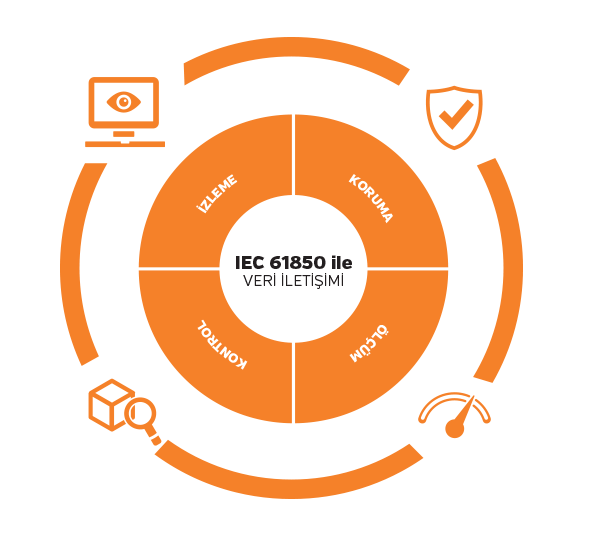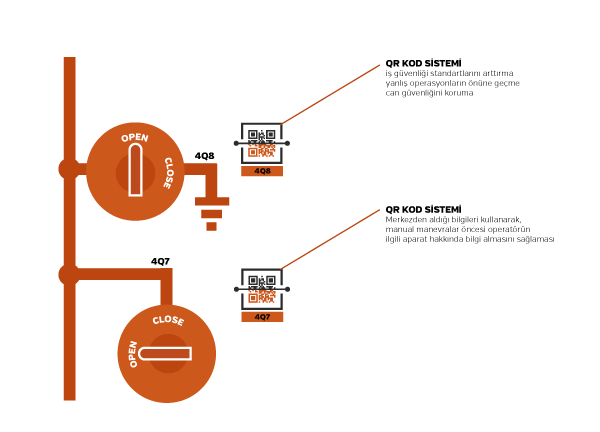Enerji Otomasyonu & SCADA Sistemleri
IEC 61850 TABANLI TRAFO MERKEZİ OTOMASYONU
IEC 61850
IEC 61850 otomasyonla kontrol edilen trafo merkezlerinin haberleşme sistemleri için oluşturulmuş uluslararası bir standarttır. Bu yeni standart rölelerarası tanımlanan sinyal alışverişi ile Trafo Merkezlerinde tüm ekipmanların koruma kontrol ölçüm ve izlemesine olanak sağladığı gibi, yüksek hızlı trafo koruma uygulamaların(kilitleme ve bağlı-açma) verimli şekilde çalışmasını hedefler.

Şalt Otomasyon Sistemi Şeması
IEC61850 protokolünün oluşturulmasının altındaki en büyük amaç üreticiden bağımsız haberleşme altyapısının oluşturulmasıdır. Bu sayede trafo merkezi otomasyonu çözümlerinde, üreticisi farklı olsa dahi, protokolü destekleyen bütün cihazlar ile iletişim sağlanmış olur.
Bundan önceki haberleşme sistemlerde cihazların kendi aralarındaki haberleşme için farklı, üst sistemle oluşturulacak haberleşme için farklı protokollerin kullanılması gerekiyorken ve bunu yalnızca kendi ürün yelpazeleri içerisinde yapabiliyorken, IEC 61850 ile enerji otomasyonu sistemleri için tek bir protokol tanımlanmaktadır ve bütün cihazlar birbirleri ile ve gerekirse bir üst sistem ile haberleşebilmektedir.
Rölelerarası kablo çekim işçiliğini ortadan kaldırmakla beraber bağlantıdayanlışlık, panolarda aşırı kablo yığını ve kablo yığınında doğan bakım gerekliliğini ortadan kaldırmaktadır.
Yazılım tabanlı olması koruma felsefesinde eklenecek çözümlerin uygulanmasında esneklik yaratmaktadır. Proje aşamasında öngörülmeyen fakat ileriki zamanlarda doğabilecek isteklerde sistemin durdurulmasını, kablo çekilmesini, fizik selin put/out put sayısının yetersizliği S1k1nt1lar ile kar1la1lmadan çözüm üretilmesine izin vermektedir.
KESİR' in Şalt Otomasyon Çözümlerinden Bazıları
Uzaktan erişim, SCADA izleme ve kontrolü, olay kaydı da dahil olmak üzere şalt otomasyon mimarisinin tasarlanması.
Şalt Otomasyonu için geleceğe yönelik iş stratejilerinin belirlenmesi.
Mevcut sistemleri değerlendirip, stratejilerini geliştirerek, yeni uygulamalar ve teknolojilere entegrasyonu sağlamak.
Koruma ve Fider yönetim rölelerinden sistemdeki en alt cihaza kadar server, RTU, endüstriyel switch, Firewall, Router vb. tüm cihazların detaylı incelemesi, seçiminin yapılması ve dokümantasyonlarının yapılması.
Operatör ve mühendis kadrolarına münferit olarak amaca yönelik teknik ve işletme eğitimlerinin uzman kadromuz tarafından verilmesi.
Yalnızca sistem tasarımı değil, aynı zamanda montaj, test ve devre alma süreçlerinde tüm çözümlerin ve devam eden süreçlerde bakım hizmetlerinin sunulması.
QR Code
QR Code sistemi, Kesir tarafından, iş güvenliği standartlarını arttırmak adına geliştirilmekte olan, yanlış operasyonların önüne geçip can güvenliğini korumayı amaç edinen bilgilendirme sistemidir.
Merkezden aldığı bilgileri kullanarak çalışan sistem, kilitlemeleri ve uyarıları QR Code taraması yapabilen cihazlar aracılığı ile kullanıcıya sunabilen bir ara yüzdür. Şalt da bulunan aparatlara koyulması planlanan QR Code etiketleri, yakından manual olarak yapılacak manevralar öncesi operatörün ilgili aparat hakkında bilgi almasını sağlayacak olup, olası bir yanlış manevranın önüne geçilmesini sağlayacaktır.
SAS Bakım Çalışmaları
Uzak Bakım Ve Destek
Bilgisayar Donanımı İçinde bulunan yazılımlar veya Bilgisayar Çevre Birimleri, Ağ Bileşenleri, Kontrol sistemine ait donanımsal veya yazılımsal herhangi bir sorun meydana geldiğinde veya herhangi bir sorun meydana gelmemesi için IT ürünlerine veya genel sisteme müdahale edilip sorunların giderilmesi ve gereken önlemlerin alınması hizmetlerini, danışmanlık, destek ve bilişim hizmetlerini kapsar.
Bakım ve Destek Çalışmaları Nelerdir?
7/24 TELEFON DESTEĞİ
7/24 UZAK ERİŞİM HİZMETİ
7/24 SAHA SERVİS HİZMETİ
KESİR' in SAS Otomasyon Çözümleri ile Size Sunduğu Avantajlar
1- Siber Güvenlik çalışmaları,
2-HW/SW Sinyal Testleri,
3- Database Kontrolleri,
4-İşletim Sistemi Bakımları,
5- Kullanıcıların İzlenmesi,
6-Sistem Süreçlerinini izlenmesi ve Log üzerindeki değişimleri
7-Backupların güncel hale getirilmesi ve testleri
8-Verimlilik ile ilgili tıkanıklılıkların çözümlenmesi
